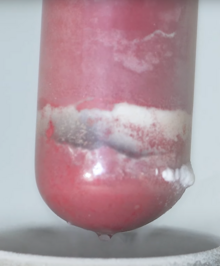Tungsten hexachloride
 α-Tungsten hexachloride
| |||
 β-Tungsten hexachloride
| |||
| |||
| Names | |||
|---|---|---|---|
| IUPAC names
Tungsten hexachloride
Tungsten(VI) chloride | |||
| Identifiers | |||
3D model (JSmol)
|
|||
| ECHA InfoCard | 100.032.980 | ||
| EC Number |
| ||
PubChemCID
|
|||
| RTECS number |
| ||
| UNII | |||
CompTox Dashboard(EPA)
|
|||
| |||
| |||
| Properties | |||
| WCl6 | |||
| Molar mass | 396.54g·mol−1 | ||
| Appearance | dark blue crystals, moisture sensitive | ||
| Density | 3.52 g/cm3 | ||
| Melting point | 275 °C (527 °F; 548 K) | ||
| Boiling point | 346.7 °C (656.1 °F; 619.8 K) | ||
| Hydrolyzes | |||
| Solubilityin chlorocarbons | soluble | ||
| −71.0·10−6cm3/mol | |||
| Structure | |||
| α:rhombohedral, β: hexagonal | |||
| Octahedral | |||
| 0D | |||
| Hazards | |||
| Occupational safety and health(OHS/OSH): | |||
Main hazards
|
oxidizer; hydrolysis releases HCl | ||
| Related compounds | |||
Otheranions
|
|||
Related compounds
|
|||
Except where otherwise noted, data are given for materials in theirstandard state(at 25 °C [77 °F], 100 kPa).
| |||
Tungsten hexachlorideis aninorganic chemical compoundoftungstenandchlorinewith thechemical formulaWCl6.This dark violet-blue compound exists asvolatilecrystals understandard conditions.It is an important starting reagent in the preparation of tungsten compounds.[1]Other examples of charge-neutral hexachlorides arerhenium(VI) chlorideandmolybdenum(VI) chloride.The highly volatiletungsten hexafluorideis also known.
As ad0atom, tungsten hexachloride isdiamagnetic.
Preparation and structure
[edit]Tungsten hexachloride can be prepared by chlorinating tungsten metal in a sealed tube at 600 °C:[2]
- W + 3 Cl2→ WCl6
Tungsten hexachloride exists in both blue and redpolymorphs,referred to respectively as α and β. The wine-red β can be obtained by rapid cooling, whereas the blue α form is more stable atroom temperature.Although these polymorphs are distinctly colored, their molecular structures are very similar. Both polymorphs featureWCl6molecules that haveoctahedral geometry,in which all six W–Cl bonds are equivalent, and their length is equal to 224–226pm.The densities are very similar: 3.68 g/cm3for α and 3.62 g/cm3for β. The low-temperature form is slightly more dense, as expected.[3]
Reactions
[edit]Tungsten hexachloride is readilyhydrolyzed,even bymoistair,giving the orangeoxychloridesWOCl4andWO2Cl2,and subsequently,tungsten trioxide.WCl6is soluble incarbon disulfide,carbon tetrachloride,andphosphorus oxychloride.[2]
Methylationwithtrimethylaluminiumaffordshexamethyl tungsten:
- WCl6+ 3 Al2(CH3)6→ W(CH3)6+ 3 Al2(CH3)4Cl2
Treatment withbutyl lithiumaffords areagentthat is useful fordeoxygenationofepoxides.[4]
ThechlorideligandsinWCl6can be replaced by manyanionicligands including:bromide,thiocyanate,alkoxide,alkylandaryl).
ReductionofWCl6can be effected with a mixture oftetrachloroethyleneandtetraphenylarsonium chloride:[5]
- 2 WCl6+ Cl2C=CCl2+ 2 (C6H5)4AsCl → 2 (C6H5)4As[WCl6] + Cl3C−CCl3
The W(V) hexachloride is a derivative oftungsten(V) chloride.
It reacts witharsenicorhydrogen arsenideto formtungsten arsenide.[6][7]
Safety considerations
[edit]WCl6is an aggressivelycorrosiveoxidant,and hydrolyzes to releasehydrogen chloride.
References
[edit]- ^J. W. Herndon; M. E. Jung (2007). "Tungsten(VI) Chloride".Encyclopedia of Reagents for Organic Synthesis.Wiley.doi:10.1002/9780470842898.rt430.pub2.ISBN978-0-471-93623-7..
- ^abM. H. Lietzke; M. L. Holt (1950). "Tungsten(VI) Chloride (Tungsten Hexachloride)".Inorganic Syntheses.Vol. 3. p. 163.doi:10.1002/9780470132340.ch44.ISBN978-0-470-13162-6.
- ^J. C. Taylor; P. W. Wilson (1974)."The Structure of β-Tungsten Hexachloride by Powder Neutron and X-ray Diffraction".Acta Crystallographica.B30(5): 1216–1220.Bibcode:1974AcCrB..30.1216T.doi:10.1107/S0567740874004572..
- ^M. A. Umbreit, K. B. Sharpless (1990)."Deoxygenation of Epoxides with Lower Valent Tungsten Halides: trans-Cyclododecene".Organic Syntheses;Collected Volumes,vol. 7, p. 121.
- ^Uhl, G.; Hey, E.; Becker, G.; Weller, F.; Dehnicke, K. (1983)."Über die Reaktion von 2,2-Dimethylpropylidinphosphan mit Wolframhexachlorid; die Kristallstrukturen von [(Cl3PO)WCL4(H9C4CCC4H9)] und [(H5C6)4As][WCL6] ".Zeitschrift für Anorganische und Allgemeine Chemie.497(2): 213–223.doi:10.1002/zaac.19834970221.
- ^Lassner, Erik; Schubert, Wolf-Dieter (2012-12-06).Tungsten.Springer Science & Business Media. p. 145.ISBN978-1-4615-4907-9.
- ^Meyer, R. J. (2013-09-03).Wolfram(in German). Springer-Verlag. p. 207.ISBN978-3-662-13401-6.


